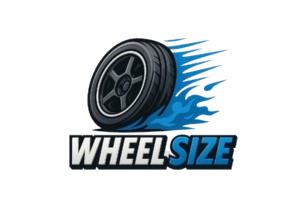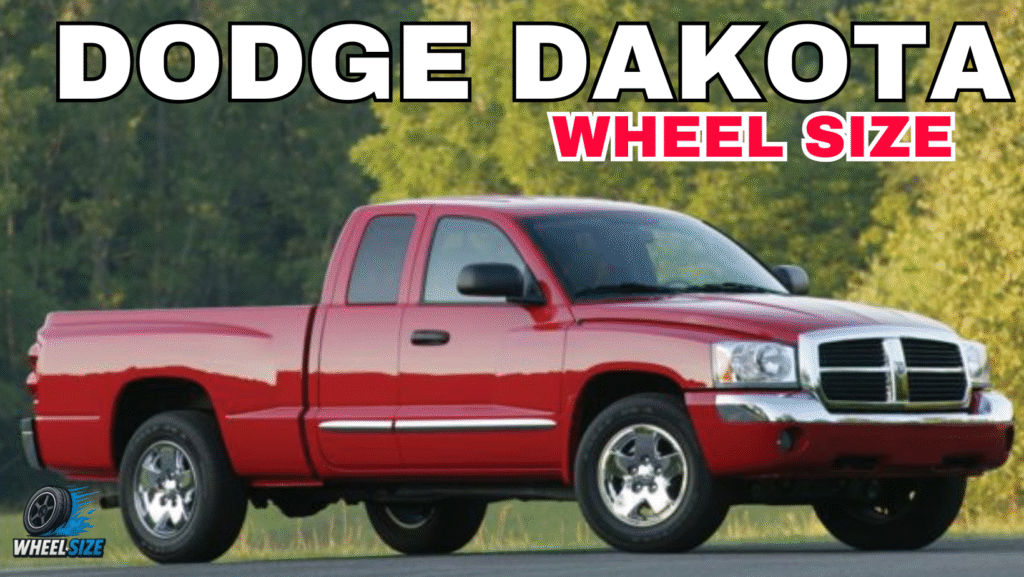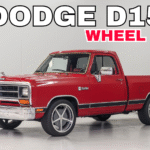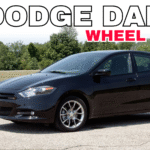The Dodge Dakota is an important part of pickup history since it was one of the first real mid-size trucks. It was more useful than compacts but easier to drive than full-size trucks. When you want to improve or keep your Dakota in good shape, wheel fitting is quite important because it affects performance, safety, and style. Choosing the perfect wheels makes sure that there is enough space, stops needless wear, and makes driving more comfortable overall. Before making any adjustments, it’s crucial to know the factory setup and any prospective upgrades because wheel specs are different for each generation of Dakota. This book tells you how to fit wheels on each generation of truck and gives you useful advice on how to choose the best wheels for your truck.
Understanding Wheel Fitment Basics
Before getting into the specifics of Dakota, it’s important to know the basics of wheel fitment. The most important things are the bolt pattern, offset, wheel diameter, width, and center bore. The bolt pattern tells you if a wheel can fit on your truck, while the offset and width tell you how much space there is between the suspension and fenders. The size of the tires is also important because if the combinations are too big, they can rub against each other. A proper fit makes handling more predictable, improves ride quality, and even wears down tires. Whether you’re getting new wheels or upgrading to aftermarket ones, making sure they fit and sizing them correctly will save you money. If you know these basics, it will be lot easier to choose wheels for your Dakota that not only look good but also work well.
Dodge Dakota DN I (1987–1996) Wheel Fitment
The first-generation Dakota came with 5-lug wheels that were usually 15 inches in diameter. Depending on the trim and options, the wheels could be small for everyday driving or a little broader for models with more capacity. The sizes of the tires were chosen to strike a compromise between comfort and load capacity. These initial sizes may seem small by today’s standards, but they were a good fit for the time. They made handling predictable and kept suspension wear to a minimum.
| Year | Hub Bore (mm) | Bolt Pattern (PCD) | Thread Size | OEM Tire Size | OEM Rim Size | Offset Range (mm) | Tire Pressure (F/R, bar) | Aftermarket Wheel Size Range |
|---|---|---|---|---|---|---|---|---|
| 1987 | 71.6 | 5×114.3 | 1/2″ – 20 UNF | 195SR14 94S | 6JJx14 ET37 | 35 – 39 | 2.0 | 14″ – 16″ |
| 1988 | 71.6 | 5×114.3 | 1/2″ – 20 UNF | 195SR14 94S | 6JJx14 ET37 | 35 – 39 | 2.0 | 14″ – 16″ |
| 1989 | 71.6 | 5×114.3 | 1/2″ – 20 UNF | 195SR14 94S | 6JJx14 ET37 | 35 – 39 | 2.0 | 14″ – 16″ |
| 1990 | 71.6 | 5×114.3 | 1/2″ – 20 UNF | 195SR14 94S | 6JJx14 ET37 | 35 – 39 | 2.0 | 14″ – 16″ |
Upgrade & Modification Options
Owners of older Dakotas frequently want to change to bigger wheels or aftermarket alloys to make their cars look stronger. Many fans upgrade to 16- or 17-inch wheels and couple them with contemporary tires for better traction. Because of the way the suspension is set up on this model, it’s crucial to keep an eye on the offset and backspacing. Choosing wheels that are made just for older Dakotas makes sure they fit right and don’t rub.
Dodge Dakota DN II (1997–2004) Wheel Fitmen
The second-generation Dakota had a 6-lug layout, which made it possible to use bigger and stronger wheels. Depending on the trim level, factory sizes usually came with 15- or 16-inch wheels. Sport and higher-end models frequently included wider wheels and better tire packages to improve traction and stability. These OEM specs offered a good balance of usefulness and ride comfort, making them good for both professional and personal use.
| Year | Hub Bore (mm) | Bolt Pattern (PCD) | Thread Size | OEM Tire Size | OEM Rim Size | Offset Range (mm) | Tire Pressure (F/R, bar) | Aftermarket Wheel Size Range |
|---|---|---|---|---|---|---|---|---|
| 1997 | 71.6 | 6×114.3 | 1/2″ – 20 UNF | 215/75R15 99S | 6JJx15 ET37 | 35 – 39 | 2.2 | 15″ – 17″ |
| 1998 | 71.6 | 6×114.3 | 1/2″ – 20 UNF | 215/75R15 99S | 6JJx15 ET37 | 35 – 39 | 2.2 | 15″ – 17″ |
| 1999 | 71.6 | 6×114.3 | 1/2″ – 20 UNF | 215/75R15 99S | 6JJx15 ET37 | 35 – 39 | 2.2 | 15″ – 17″ |
| 2000 | 71.6 | 6×114.3 | 1/2″ – 20 UNF | 215/75R15 99S | 6JJx15 ET37 | 35 – 39 | 2.2 | 15″ – 17″ |
| 2001 | 71.6 | 6×114.3 | 1/2″ – 20 UNF | 215/75R15 99S | 6JJx15 ET37 | 35 – 39 | 2.2 | 15″ – 17″ |
| 2002 | 71.6 | 6×114.3 | 1/2″ – 20 UNF | 215/75R15 99S | 6JJx15 ET37 | 35 – 39 | 2.2 | 15″ – 17″ |
Upgrade & Modification Options
The DN II Dakota is very easy to improve because it has a stronger frame and suspension. Many owners upgrade to 17- or 18-inch wheels, which make the car look better without making it harder to drive. Wider wheels with all-terrain tires are usual for off-road configurations, but you need to be careful with backspacing so that the wheels don’t touch when the suspension flexes. Drivers can choose between a rugged work truck style and a sportier street flair with this generation.
Dodge Dakota DN III (2005–2011) Wheel Fitment
The last Dakota had a lot of different wheel options, from simple 16-inch steel wheels to bigger 17- and 18-inch alloys. The 6-lug pattern stayed the same, but factory installations were broader to handle more weight and towing. Many trims, notably the higher-spec ones, had more aggressive tire profiles that gave them better traction. These factory sizes were a good mix of tough and smooth, so they could be used by a lot of different kinds of owners.
| Year | Hub Bore (mm) | Bolt Pattern (PCD) | Thread Size | OEM Tire Size | OEM Rim Size | Offset Range (mm) | Tire Pressure (F/R, bar) | Aftermarket Wheel Size Range |
|---|---|---|---|---|---|---|---|---|
| 2005 | 77.8 | 5×139.7 (5×5.5) | 9/16″ – 18 UNF | 245/70R16 101S | 7Jx16 ET25.4 | 23.4 – 27.4 | 2.4 | 16″ – 18″ |
| 2006 | 77.8 | 5×139.7 (5×5.5) | 9/16″ – 18 UNF | 245/70R16 101S | 7Jx16 ET25.4 | 23.4 – 27.4 | 2.4 | 16″ – 18″ |
| 2007 | 77.8 | 5×139.7 (5×5.5) | 9/16″ – 18 UNF | 245/70R16 101S | 7Jx16 ET25.4 | 23.4 – 27.4 | 2.4 | 16″ – 18″ |
| 2008 | 77.8 | 5×139.7 (5×5.5) | 9/16″ – 18 UNF | 245/70R16 101S | 7Jx16 ET25.4 | 23.4 – 27.4 | 2.4 | 16″ – 18″ |
| 2009 | 77.8 | 5×139.7 (5×5.5) | 9/16″ – 18 UNF | 245/70R16 101S | 7Jx16 ET25.4 | 23.4 – 27.4 | 2.4 | 16″ – 18″ |
| 2010 | 77.8 | 5×139.7 (5×5.5) | 9/16″ – 18 UNF | 245/70R16 101S | 7Jx16 ET25.4 | 23.4 – 27.4 | 2.4 | 16″ – 18″ |
| 2011 | 77.8 | 5×139.7 (5×5.5) | 9/16″ – 18 UNF | 245/70R16 101S | 7Jx16 ET25.4 | 23.4 – 27.4 | 2.4 | 16″ – 18″ |
Upgrade & Modification Options
People who love DN III Dakotas typically put 18- to 20-inch aftermarket wheels on them to match the truck’s tough look. Lift kits are widespread and let you put on bigger off-road tires that give you more ground clearance and a better stance. People who drive on the street may want performance wheels with lower-profile tires because they make the car handle better. This generation’s suspension geometry is stronger, which gives you more room to try new things. However, the right offset is still very important to avoid clearance difficulties with brakes and fenders.
Common Wheel Bolt Patterns for Dodge Dakota
The Dakota had two major bolt designs over the years. The original generation (1987–1996) had a 5-lug pattern, however the second and third generations (1997–2011) changed to a 6-lug style. This adjustment was made so that the wheels could be stronger and carry more weight. Before you go shopping for new or replacement wheels, you need to know your truck’s bolt pattern. Even if the wheel size is perfect, it won’t fit if the lug count is off. A fast look at the right pattern can save you time and make sure it fits right.
Tips for Choosing the Right Wheels for Your Dakota
It’s crucial to think about how you want to use your Dodge Dakota when you choose wheels for it. Lightweight alloys that make cars more comfortable to ride in and get better gas mileage are good for daily drivers. People who like to go off-road might like steel or reinforced alloy wheels with all-terrain or mud tires for extra strength. If you’re making changes to the suspension, always double-check the offset, backspacing, and tire diameter to be sure there won’t be any clearance issues. Quality brands made for mid-size trucks provide you peace of mind because they fit perfectly and endure a long time. You may get the proper mix of appearance, safety, and usefulness by choosing wheels that fit your truck’s purpose.
Final Thoughts
Each of the three versions of the Dodge Dakota had its own wheel fitment characteristics, so it’s crucial to know the right requirements for your model. As the Dakota changed over time, the number of wheel options grew. The early trucks had 5-lug wheels, and the later ones had 6-lug wheels. If you’re restoring a classic first-gen or upgrading a newer model for off-road fun, make sure the wheels fit properly so you can count on them to work. This guide will help you choose wheels that meet your Dakota’s needs and style.



